 The image here is the annual average temperature anomalies in 2022 compared to the 1981-2010 baseline average. The image uses data from the Berkeley Earth high-resolution data set as noted in the article Introducing the Berkeley Earth High-Resolution Dataset by Robert Rohde (3/28/2023):
The image here is the annual average temperature anomalies in 2022 compared to the 1981-2010 baseline average. The image uses data from the Berkeley Earth high-resolution data set as noted in the article Introducing the Berkeley Earth High-Resolution Dataset by Robert Rohde (3/28/2023):
The new Berkeley Earth High Resolution Data Set improves upon the previous version by providing a 0.25° x 0.25° lat-long resolution (approximately 30 km at the equator), which is four times higher than the previous 1° x 1° resolution. This allows for a more accurate representation of small-scale temperature variations, particularly in areas where geography is changing rapidly, such as coastlines and mountainous terrain. It also does a better job of capturing ocean variations related to currents and other structures. The new gridded data product derives its information from approximately 50,000 weather stations and more than 450,000,000 ocean temperature measurements, providing excellent coverage of the Earth’s surface.
The good news is the Berkeley Earth makes this data available on its data page. Read more about the data and processing in the article.
